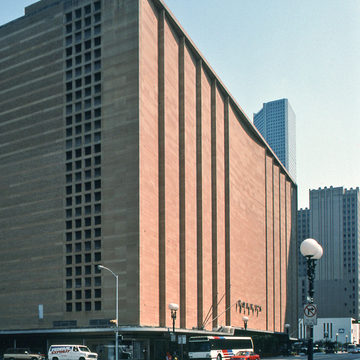You are here
Macy's (Foley's)
Until it was absorbed into the Macy's chain in 2006, Foley's was Houston's hometown department store. In 1945 Foley's bought one-and-a-half city blocks seven blocks away from its earlier store in what had become, during the 1920s, the prime retail sector along Main Street. Foley's hired Houston architect Kenneth Franzheim and New York City designer William T. Snaith of Loewy and Snaith to design the block-square, six-story, windowless building (which Franzheim expanded to ten stories in 1957). When Foley's opened in 1947, it was acclaimed as the model downtown department store of the postwar era. The building is Franzheim's masterpiece. It is a box whose surfaces are detailed with such intelligence, tact, and subtlety that they transform boxiness into an urban virtue.
Foley's is adjacent to Main Street Square, installed in the 1000 block of Main Street in 2004 in conjunction with construction of the Metrorail Red Line. Designed by Ehrenkrantz Eckstut and Kuhn of Los Angeles and Pierce Goodwin Alexander Linville (PGAL Architects) , with lighting design by Fisher Marantz Stone, the square is a basin that fills the street right-of-way, over which the jump and pop jets of fountains play. Houston artist Floyd Newsum produced the vividly colored sculptural accompaniment. Across from Foley's at 1111 Main Street is the former Sakowitz Brothers specialty store of 1951 by Alfred C. Finn, a late modernist composition faced with polished white Vermont marble. It is now a parking garage.
Writing Credits
If SAH Archipedia has been useful to you, please consider supporting it.
SAH Archipedia tells the story of the United States through its buildings, landscapes, and cities. This freely available resource empowers the public with authoritative knowledge that deepens their understanding and appreciation of the built environment. But the Society of Architectural Historians, which created SAH Archipedia with University of Virginia Press, needs your support to maintain the high-caliber research, writing, photography, cartography, editing, design, and programming that make SAH Archipedia a trusted online resource available to all who value the history of place, heritage tourism, and learning.


